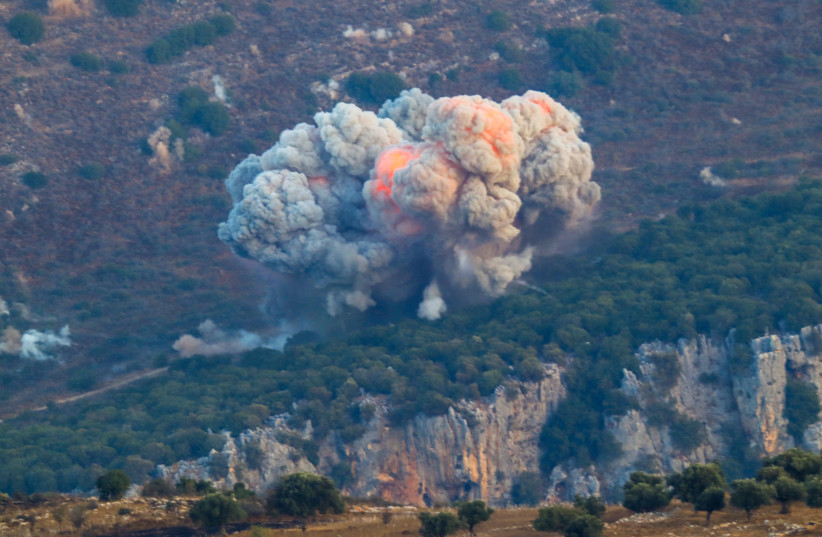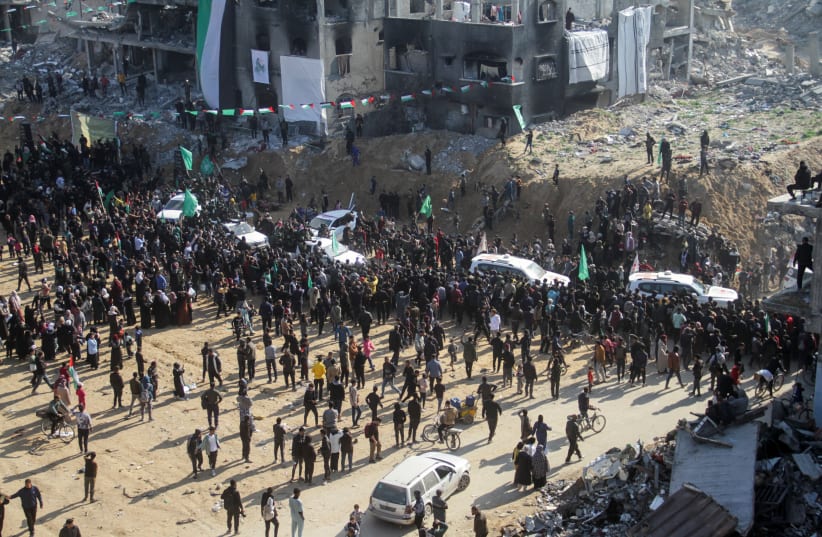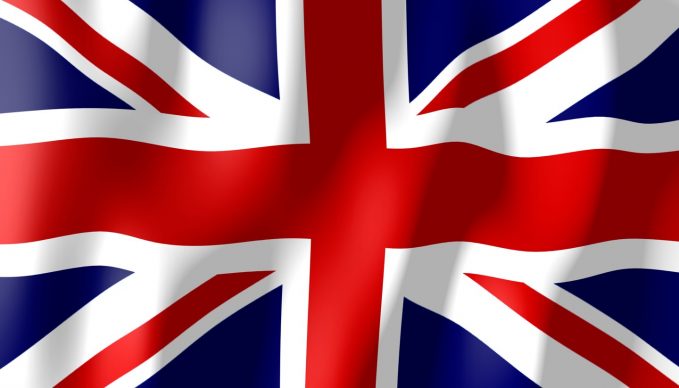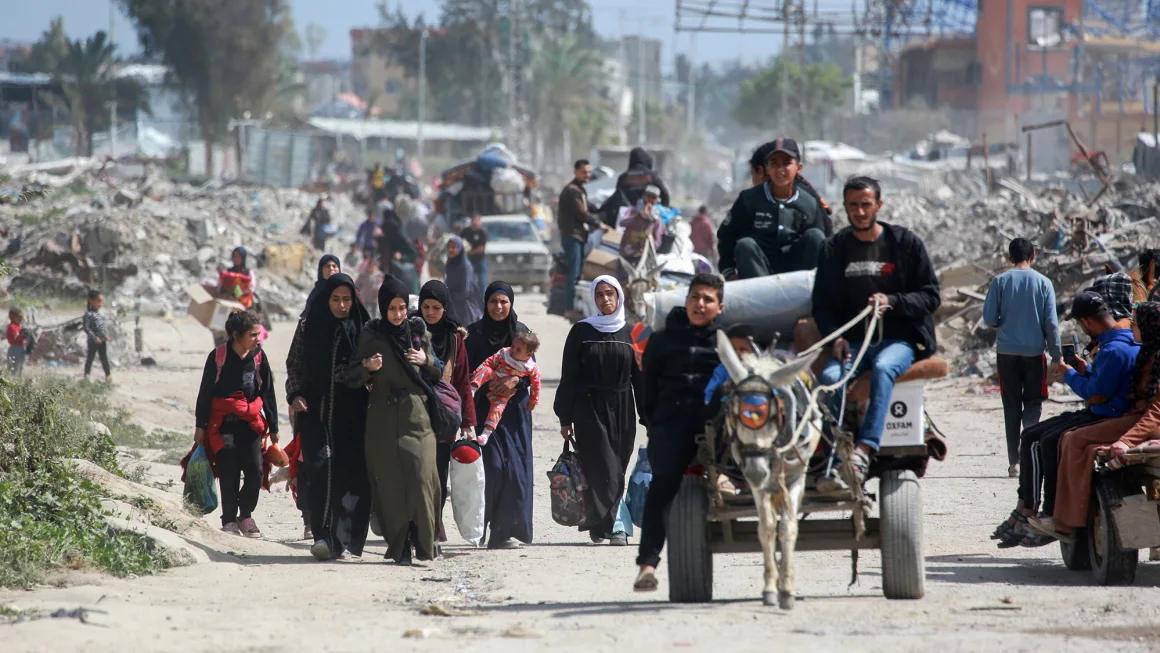Foreign
IDF carries out largest attack on Hezbollah since 2006, causes mass evacuations in Lebanon

Terror group fires back, sirens in West Bank • Beirut: 1,200 wounded, approximately 350 dead • Haifa region under restrictions

The IDF battered Hezbollah with the largest attack since the Second Lebanon War (2006) on Monday. The attack was broken down roughly into four massive rounds of air strikes against rockets and other assets. The Iranian proxy group tried hard to fight back but had very limited success in relative terms.

The figures from Monday’s attacks, along with the days preceding, were staggering and also led to enormous waves of evacuations of Lebanese civilians from both southern Lebanon and the Bekaa Valley area.
The IDF struck over 1,300 targets in around 650 sorties; the Lebanese Health Ministry estimated well over 1,200 wounded and close to 350 dead.
Military sources refused to speculate on the ratio of operatives to civilians, though they clarified that the targets were all places where Hezbollah had rockets, drones, or missiles located, ready to fire on Israeli civilians. IDF chief spokesman R.-Adm. Daniel Hagari made a general statement, suggesting that many of those killed would be Hezbollah fighters readying to shoot at Israel.
Defense Minister Yoav Gallant said that the military’s continuous strikes in recent days destroyed tens of thousands of rockets, with some commentators noting that the attacks could be impacting aspects of Hezbollah’s strategic capabilities to wage a war against Israel.
Smoke billows from the site of an Israeli airstrike in Marjayoun, near the Lebanon-Israel border, on September 23, 2024. The Israeli military on September 23 told people in Lebanon to move away from Hezbollah targets and vowed to carry out more ”extensive and precise” strikes against the Iran-back (credit: RABIH DAHER/AFP via Getty Images)
Hezbollah fired – almost non-stop – rounds of dozens of rockets across the entire North, over 200 rockets throughout Monday, which extended all the way down to Haifa.
For the first time, Hezbollah fired approximately 10 long-range rockets at the northern West Bank. Some commentators speculated this was a signal of threat to Israel – given that if they could reach there, they could also reach Tel Aviv – if Hezbollah decided to aim that far.
Unconfirmed reports and videos showed a rocket that struck and caused damage to a Palestinian town in the West Bank.
The North and Haifa areas were effectively shut down by these attacks, including all educational frameworks. These areas may remain shuttered for an extended period, if neither side steps back from this developing war of attrition, or is unable to deal a decisive blow.
Areas like Safed began to look more abandoned, much like the areas in the North that had been evacuated. They have looked like that for 11 months, as 60,000 residents were evacuated on Oct. 8.
Late Monday night, the Israel Air Force (IAF) attempted to assassinate Ali Karaki, Hezbollah’s third in command the last remaining living member of a triumvirate of top military advisers to Hezbollah chief Hassan Sayyed Nasrallah. Reports were mixed about whether he survived the strike, but at the very least, he appeared to be wounded, with estimates that he would not be able to act in a command capacity for some time.
Karaki was supposed to replace Ibrahim Aqil, the Hezbollah Radwan special forces chief assassinated by Israel on Friday.
These two key losses to Nasrallah followed the loss of his top military adviser Fuad Shukr on July 30.
And still, by press time, there was still no clear sign that either side was close to accepting the dictates of the other for ending the conflict.
Israel to press forward until Hezbollah stops
Israel has said that it will continue to attack Hezbollah until it stops firing rockets and commits to keeping southern Lebanon clear of its Radwan forces.
Hezbollah has said it will keep firing rockets at Israel until the IDF reaches a ceasefire with Hamas in Gaza, no matter the consequences to its own home front.
Hagari gave three speeches throughout the day on Monday, signaling the different stages of escalating the conflict.
The first wave of attacks took place around 6:30 a.m. Hagari spoke around 7:50 a.m., summarizing the impact of the strikes to date, and warning Lebanese civilians to leave any structures in southern Lebanon where Hezbollah concealed weapons.
Hagari’s warning was unusual and different from mass evacuation warnings issued to date in Gaza.
On the one hand, it was the first mass evacuation warning to southern Lebanese regarding areas where Hezbollah is operating. Hundreds of thousands of residents in southern Lebanon evacuated on Monday areas where the IDF has been striking for several months. So, the warning would be to those who have not yet left.
On the other hand, the IDF did not say to completely leave all of southern Lebanon.
It was not clear where the IDF would suggest these civilians should go permanently if in fact their homes get bombed due to holding terror assets.
It further differs from Gaza evacuation orders in that Hagari did not suggest a ground invasion. He rather said the military would be striking more intensely from the air, including at civilian locations where terror assets have been located.
To illustrate his point, Hagari displayed an example of a location in southern Lebanon where the IDF, a few weeks ago, witnessed Hezbollah troopers knock down some of the walls to set up a camouflaged civilian location for the firing of a Russian-made DR-3 cruise missile, with hundreds of kilos of explosives.
Hagari said that the missile posed a much larger danger than typical Hezbollah rockets because it flies lower and faster in a line-drive type fashion – as opposed to rockets, which fly slower and in an arch trajectory. He added that this missile had been smuggled to Hezbollah via Syria.
Hagari then showed the IDF watching Hezbollah terrorists exiting the area. Troops then blew up both the cruise missile and the civilian location where it was hidden, along with the Hezbollah terrorists.
Despite not threatening a ground invasion yet, calls for such an invasion have been rising, including from opposition figures such as National Unity chairman Benny Gantz and Labor chairman Yair Golan, while hard-right figures like Religious Zionist Party chairman and Finance Minister Betzalel Smotrich, and Otzma Yehudit chairman and National Security Minister Itamar Ben Gvir have been calling for such a move for months.
One of the purposes of Hagari’s public statements, which included Arabic subtitles, was to broaden the warning to civilians in southern Lebanon to leave such areas. Another purpose was to preempt Western criticism for targeting civilian areas and to explain the IDF’s justification.
Under international law, civilian areas can be targeted – if warnings are provided beforehand, and if those areas have been used for military purposes. They effectively become military targets.
The second wave began at around 11:00 a.m. Video footage showed many people and vehicles attempting evacuation.
After reports that UNIFIL had evacuated southern Lebanon as well, a spokesperson for the organization clarified to The Jerusalem Post, “Ensuring the safety and security of our personnel is important. While many of our civilian staff have been operating from various parts of Lebanon, as a precautionary measure, those remaining in the south have been advised to relocate to safety in the north.”
They added that its peacekeepers and a few civilians “will remain present and continue the mission’s essential work… No evacuation, but relocation for staff that can work from home. Critical staff will stay south.”
Hagari gave his second speech at around 2:45 p.m. This time, he warned civilians to evacuate Bekaa Valley areas. He said that Hezbollah hid rockets, drones, and long-range strategic weapons there. Bekaa is farther from the border with Israel, which means that collecting intelligence about the weapons and targeting them is more difficult for Israel.
While the impact of Hagari’s warning seemed to be to cause a mass evacuation, the IDF did not confirm that it had been fully evacuated, rather it again focused on residences where weapons were hidden.
However, given that the IDF has accused Hezbollah of hiding weapons in every three to five houses in various parts of Lebanon, Hagari’s threat appeared to cause another mass evacuation.
He further pushed back on global criticism of rising casualties in Lebanon due to the IDF’s decision to target civilian areas, saying that the videos of large explosions circulating on social media prove that Hezbollah hid powerful weapons in these areas, causing secondary explosions.
He showed a video of an attack on a structure at Jabal al-Butum with what appeared to be tremendous secondary explosions. If the IDF had bombed a house that did not contain weapons, the secondary explosions wouldn’t have occurred.
Moreover, he said that the goal of the third wave of attacks would be to stop what the military viewed as an imminent decision by Hezbollah to fire on Israel, using some of its strategic weapons in the Bekaa Valley area.
Despite the more sensitive Bekaa Valley attack, Hagari did not change the status of Home Front restrictions, which currently only apply to the Haifa Bay Area and northward.
At around 4:45 p.m., the IDF started another wave of strikes on the Bekaa Valley – as Hagari had warned.
The mass evacuations from there caused a new dilemma for Nasrallah, as it is unclear if the economically weakened Lebanon – stuck in a political and economic crisis long before the war – could manage running large refugee camps for its people caused by the evacuations. It is also possible that some of these refugees in Bekaa are Sunnis and Christians, as opposed to southern Lebanon, which is virtually all Shiite.
Shortly after these attacks, Hezbollah responded with one of its largest salvos of rockets, leading to the IDF’s fourth wave at around 5:45 p.m.
The IDF’s air defense seemed to successfully shoot down the vast majority of aerial attacks which risked hitting populated areas, while the military appeared to allow a significant number of rockets to land in open spaces, at times causing fires and damage.
There also appeared to be around a dozen or more instances of rockets landing in populated areas or on important roads.
Late Sunday, Hagari said there were no changes to the home front situation. While many analysts have marveled at the IDF’s ability to prevent scenes of mayhem and mass destruction which defense officials consistently predicted in any all-out conflict with Hezbollah, former IDF air defense chief Brig.-Gen. (res.) Ran Kochav voiced caution.
Kochav noted that Hezbollah still retains most of its long-range precision rocket capabilities for striking Tel Aviv and central Israel, as well as the vast majority of its pre-war 150,000 rocket arsenal – not to mention its retro-technology drone fleet – which has thrown the IDF’s advanced defenses for a loop.
Hagari gave his third speech at 8:45 p.m., flagging a number of specific threats that the military struck on Monday. He noted the destruction of many cruise missiles, which could fly hundreds of km. and carry as much as 1000 kgs. of explosives.
Hagari said that one such missile – which the military destroyed on the ground before it could be fired – was identical to the kind that killed 12 Druze children playing in a soccer field in Majdal Shams at the end of July.
He added that the military destroyed another category of mid-range rockets, which could have flown around 200 km., along with short-range rockets that could travel 50 km.
He said that the IDF also destroyed large attack drones – such as the Sayyad 107 – highlighting that all of these weapons were found and blown up in the heart of civilian villages, where Hezbollah hid them. He showed a large Hezbollah rocket in an attic in a residence in Domain al Tahta ready to fire on Israel.
Another example he showed of hidden Hezbollah weapons in a civilian residence displayed not only secondary explosions but showed a hidden rocket accidentally firing off at a next-door neighbor’s house and destroying it.

Foreign
Hamas claims spokesperson killed in Israeli strike on northern Gaza

Earlier this week, Israel killed Ismail Barhoum, a member of Hamas’ political office, and Salah al-Bardaweel, another senior leader.

Hamas spokesman Abdel Latif al-Qanou was allegedly killed in an Israeli airstrike on northern Gaza, Hamas-affiliated news agency Shehab reported on Wednesday night.

Al-Qanoa was one of Hamas’s most prominent spokesmen in Gaza, and while he avoided media appearances during the months of fighting, he gave multiple interviews to Arab news channels after the ceasefire.
Al-Qanoua was killed when his tent was targeted in Jabaliya, the Hamas-run Al-Aqsa television reported. The same strike wounded several people, medical sources said.
Earlier this week, Israel killed Ismail Barhoum, a member of Hamas’ political office, and Salah al-Bardaweel, another senior leader.
Both Bardaweel and Barhoum were members of the 20-member Hamas decision-making body, the political office, 11 of whom have been killed since the start of the war in late 2023, according to Hamas sources.
Tents for Palestinians seeking refuge are set up on the grounds of a United Nations Relief and Works Agency for Palestine Refugees (UNRWA) centre in Khan Yunis in the southern Gaza Strip on October 19, 2023, amid the ongoing battles between Israel and the Palestinian group Hamas (credit: MAHMUD HAMS/AFP via Getty Images)
The IDF has yet to comment on the alleged elimination.
Increased IDF pressure in the Gaza Strip
Since fighting in Gaza was renewed at the beginning of last week, the IDF has killed 150 terrorists, including 10 top Hamas officials, The Jerusalem Post learned Tuesday.
In certain areas, the military has entered a full kilometer into Gaza, such as around the Nitzanim Corridor in central Gaza.
In addition to central Gaza, Beit Lahia, Beit Hanoun, parts of Khan Yunis, Shaboura, and Tel Sultan, the IDF has been evacuating and moving into Jabaliya.

Foreign
Dead Nigerians, Africans, others without will may lose unclaimed estates in UK

Hundreds of unclaimed estates reveal untold stories of African migration, wealth, and family ties left behind.
Thousands of people die every year in the United Kingdom without leaving a will or identifying next of kin, and among them are many Nigerians and other Africans whose estates—ranging from property to savings—remain unclaimed.
The UK government’s latest list of unclaimed estates, updated daily, includes over 170 entries connected to African-born individuals, with Nigerians making up a significant portion of the cases.

A Legacy Lost
For many migrants, the UK became a home away from home—a land of opportunity where they built wealth, purchased property, and created a life.

However, the absence of a will often results in their assets being classified as “bona vacantia” (ownerless goods), leaving them to the custody of the Crown.
Families back in Africa are frequently unaware of these estates, leading to a permanent loss of assets.
Cases like that of Adenike Adebiyi, who passed away in Hackney, London, in 2004, or Solomon Adekanmibi, who died in Colchester, Essex, in 2021, highlight the consequences of dying intestate.
With no identified next of kin or missing documentation, their estates remain unclaimed, and their legacies risk being forgotten.
Why It Matters
This phenomenon underscores a critical issue: many African families are unaware of their relatives’ financial situations abroad.
Migration often disrupts communication, and without clear documentation, the wealth built overseas remains beyond reach.
The loss isn’t just financial—it’s deeply cultural and emotional. Unclaimed estates represent untold family histories, connections, and the struggles of migrants who built their lives in the diaspora.
The Challenges
Lack of Awareness:
Most families in Nigeria and other African countries are unaware of their relatives’ estates abroad or how to access them.
Genealogical Gaps:
The information provided in official records is often incomplete. For example, many entries in the UK unclaimed estates list lack detailed family history or next-of-kin information.
Cultural Hesitations:
In many African cultures, discussing death and wills is considered taboo, leading to reluctance in planning for asset distribution.
A Call to Action
African governments, community organizations, and legal professionals need to raise awareness about this issue.
Here’s what can be done:
Encouraging Will Writing: Migrants in the diaspora should be educated about the importance of drafting wills to protect their assets.
Genealogical Support: Families in Africa can be assisted in tracing unclaimed estates through local or international partnerships.
Public Awareness Campaigns: Social and traditional media can highlight the importance of estate planning and share resources for families.
How to Check the List
The UK government maintains a public Unclaimed Estates List that is updated daily.
Families can search the list by name, place of birth, or other identifiers to check for potential claims.
Final Thoughts
For many Nigerians and Africans in the UK, their unclaimed estates represent more than just wealth—it’s a story of migration, resilience, and identity.
By addressing this growing issue, families can reclaim their heritage, and the legacy of those who journeyed to the diaspora need not be forgotten.
Here is the latest daily update as of March 24, 2025. Check the list

Foreign
Israel approves controversial proposal to facilitate emigration of Palestinians from Gaza

Israel’s security cabinet has approved a controversial proposal to facilitate Palestinian emigration from Gaza, a move critics warn could amount to ethnic cleansing.

Israeli Finance Minister Bezalel Smotrich on Sunday said the security cabinet approved the proposal by Defense Minister Israel Katz to organize “a voluntary transfer for Gaza residents who express interest in moving to third countries, in accordance with Israeli and international law, and following the vision of US President Donald Trump.”

The decision marks a remarkable endorsement of a plan once considered a far-right fantasy – and comes despite the prime minister’s earlier pledge not to permanently displace Gaza’s civilian population.
Critics have said that any mass displacement of Gazans in the midst of a devastating war would amount to ethnic cleansing, an act associated with war crimes and crimes against humanity under international law. Israeli officials have countered that emigration would be voluntary and in line with international legal standards.
But aid groups argue that Israel’s war has made life in Gaza nearly impossible. Martin Griffiths, the United Nations’ top emergency relief official, has called the enclave “uninhabitable,” saying its people are “witnessing daily threats to their very existence.”
The Israeli approval would establish an administration within the defense ministry “to prepare and facilitate the safe and controlled movement of Gaza residents who wish to voluntarily move to third countries,” according to a statement from the defense ministry.
Its work would include “establishing movement routes, pedestrian checks at designated crossings in the Gaza Strip,” and infrastructure to enable people to leave.
Israeli officials have presented the plan as a fulfillment of a desire by Trump to take over Gaza, expel its Palestinian population to neighboring countries and turn it into a Middle Eastern “riviera.”
The Palestinian Authority’s Minister of State for Foreign Affairs Varsen Aghabekian Shaheen told CNN’s Becky Anderson last month that Palestinians “are steadfast to stay in their land and will not move.”
Trump’s ‘vision’
Katz said Sunday that Israel is using “all means to implement the vision of the US president,” according to the defense ministry statement.
This month, Trump appeared to backtrack on his comments about displacing Palestinians, telling reporters that “nobody is expelling any Palestinians.” Steve Witkoff, the US special envoy to the Middle East, said last month that the US initiative to rebuild Gaza won’t necessarily amount to an “eviction plan” and that it was designed to “shake up everybody’s thinking.”
Last year, Israeli Prime Minister Benjamin Netanyahu said his country had no intention to displace Palestinians or occupy Gaza.
Related articleTrump says ‘nobody is expelling Palestinians,’ weeks after saying they should be moved to Arab states
“I want to make a few points absolutely clear: Israel has no intention of permanently occupying Gaza or displacing its civilian population,” Netanyahu said in a video statement in January 2024.
Trump’s proposal has, however, brought the idea further into the mainstream, with Israeli politicians now openly discussing mass emigration of Gazans as a solution to the war. And Katz last week said that Israel may maintain a permanent presence in the enclave.
Israeli rights group Peace Now criticized the plan, saying “the establishment of the administration to expel Palestinians from Gaza is one of the stupidest moves by a government that has lost all direction and logical thinking.”
The prospect has also drawn sharp rebuke from Arab leaders, especially Egypt and Jordan, who would be expected to absorb the large number of expelled Palestinians. Experts have also warned that displacing Palestinians would further destabilize the region and threaten the security of neighboring states.
Smotrich said Sunday that the security cabinet also approved the expansion of Jewish settlements in the occupied West Bank, noting that 13 areas in the West Bank would be split from existing settlements and would be recognized as independent settlements.
“Instead of hiding and apologizing – we are raising the flag, building, and settling. This is another important step on the path to actual sovereignty in Judea and Samaria,” he said, using the name by which Israelis refer to the West Bank.
The Yesha Council, an umbrella body representing Jewish settlements, said that as of January 2024, there were 150 settlements in the West Bank.
It said that the decision exposes a “long-standing lie that (Israel) does not establish new settlements, but only ‘neighborhoods’ of existing settlements” and that it is “another nail in the coffin that the Government of Israel is preparing for the only chance for a future of peace and security.”
A statement sent by Smotrich’s office said the move comes against “the backdrop of the approval of tens of thousands of housing units in Judea and Samaria and represents another significant step in the process of normalizing and regulating the settlement.”
Smotrich and other right-wing ministers have been pushing an aggressive expansion of settlements on the path to declaring Israeli sovereignty over the West Bank, which would be in defiance of international law and UN Security Council resolutions.
Israel says it will maintain ‘permanent’ presence in Gaza unless hostages are freed

-

 Politics1 week ago
Politics1 week agoOpposition leaders announce coalition to challenge Tinubu in 2027
-

 Foreign6 days ago
Foreign6 days agoHouthis declare Ben-Gurion Airport ‘no longer safe’ after renewed Gaza fighting
-

 Politics1 week ago
Politics1 week agoYahaya Bello deceptively arranging recall of Senator Natasha, desperate to replace her – Constituents
-

 Politics1 week ago
Politics1 week agoAtiku, El-rufai, Obi condemn Tinubu’s suspension of Rivers Governor, demand reversal
-

 News1 week ago
News1 week agoWhy Christ Embassy’s Pastor Chris holds Abuja mega crusade – Fisho
-

 News7 days ago
News7 days agoUmeh denies receiving $10,000 with other 42 Senators to support state of emergency in Rivers
-

 Business1 week ago
Business1 week agoFlutterwave, FIRS collaborate to digitize tax collection in Nigeria
-

 Crime1 week ago
Crime1 week agoGhana’s anti-drug agency nabs Nigerian drug kingpin, Uchechukwu Chima, seizes $2.1m worth of cocaine, heroin









